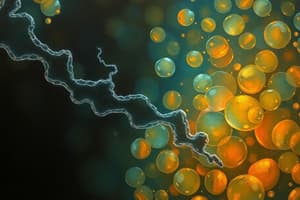Podcast
Questions and Answers
Which of the following is a common cause of fatty liver?
Which of the following is a common cause of fatty liver?
- Starvation (correct)
- Regular exercise
- High blood sugar levels
- Excessive protein intake
What is a common feature of intracellular accumulation of proteins?
What is a common feature of intracellular accumulation of proteins?
- Intracellular accumulation of proteins is not significant
- Can result from genetic defects in folding and transport (correct)
- It only occurs in the liver
- It always leads to reversible cell injury
What causes the characteristic yellow color in atherosclerotic plaques?
What causes the characteristic yellow color in atherosclerotic plaques?
- Presence of bilirubin
- Accumulation of melanin
- Smooth muscle cells filled with lipid vacuoles
- Cholesterol ester accumulation (correct)
What is the most common exogenous pigment that can accumulate in the body?
What is the most common exogenous pigment that can accumulate in the body?
Which condition is NOT associated with fatty liver?
Which condition is NOT associated with fatty liver?
What does the accumulation of carbon in the lungs lead to?
What does the accumulation of carbon in the lungs lead to?
What can result from an imbalance between fat uptake, utilization, and secretion?
What can result from an imbalance between fat uptake, utilization, and secretion?
What is responsible for the yellow color seen in atherosclerotic plaques?
What is responsible for the yellow color seen in atherosclerotic plaques?
Which among the following is a characteristic feature of glycogen storage diseases?
Which among the following is a characteristic feature of glycogen storage diseases?
What is the most common cause of fatty change in the liver?
What is the most common cause of fatty change in the liver?
What are the three categories of intracellular accumulations?
What are the three categories of intracellular accumulations?
Which location within the cell can abnormal substances accumulate?
Which location within the cell can abnormal substances accumulate?
What are the four pathways of abnormal intracellular accumulations?
What are the four pathways of abnormal intracellular accumulations?
Which term describes the accumulation of hemosiderin in tissues?
Which term describes the accumulation of hemosiderin in tissues?
In what organelles do abnormal substances typically accumulate?
In what organelles do abnormal substances typically accumulate?
In which scenario may cells accumulate abnormal amounts of various substances?
In which scenario may cells accumulate abnormal amounts of various substances?
What is the major storage form of iron in the body?
What is the major storage form of iron in the body?
Which pigment is characterized as an insoluble brownish-yellow granular intracellular material?
Which pigment is characterized as an insoluble brownish-yellow granular intracellular material?
Which condition is associated with decreased melanin pigmentation?
Which condition is associated with decreased melanin pigmentation?
What is the characteristic staining reaction of hemosiderin with a specific dye?
What is the characteristic staining reaction of hemosiderin with a specific dye?
Which pigment represents aggregates of ferritin micelles?
Which pigment represents aggregates of ferritin micelles?
In which condition does calcification occur in vital tissues with abnormal calcium metabolism?
In which condition does calcification occur in vital tissues with abnormal calcium metabolism?
What causes lipofuscin to appear as a marker of past free-radical injury?
What causes lipofuscin to appear as a marker of past free-radical injury?
Which condition leads to hemosiderosis characterized by accumulation within tissue macrophages?
Which condition leads to hemosiderosis characterized by accumulation within tissue macrophages?
How does lipofuscin appear in tissue sections?
How does lipofuscin appear in tissue sections?
Flashcards are hidden until you start studying
Study Notes
Fatty Liver and Intracellular Accumulations
- Fatty liver is commonly caused by chronic alcohol consumption, obesity, and diabetes.
- A common feature of intracellular accumulation of proteins is the formation of inclusion bodies.
- The characteristic yellow color in atherosclerotic plaques is caused by the accumulation of lipochrome, a lipid-derived pigment.
Pigments and Accumulations
- The most common exogenous pigment that can accumulate in the body is carbon, which can lead to anthracosis.
- The accumulation of carbon in the lungs leads to anthracosis, a condition characterized by black pigmentation.
- An imbalance between fat uptake, utilization, and secretion can result in fatty liver disease.
Atherosclerotic Plaques and Hemosiderin
- Lipochrome is responsible for the yellow color seen in atherosclerotic plaques.
- The term hemosiderosis describes the accumulation of hemosiderin in tissues.
- Hemosiderin is a characteristic feature of glycogen storage diseases.
Cellular Accumulations
- The three categories of intracellular accumulations are hyaline, lipid, and pigmented.
- Abnormal substances can accumulate in the lysosomes, a location within the cell.
- The four pathways of abnormal intracellular accumulations are endogenous, exogenous, myocellular, and macrophage-related.
- Abnormal substances typically accumulate in lysosomes.
Iron and Lipofuscin
- The major storage form of iron in the body is ferritin.
- Lipofuscin is a characteristic insoluble brownish-yellow granular intracellular material.
- Lipofuscin appears as a marker of past free-radical injury due to the accumulation of lipid peroxidation products.
Calcification and Melanin
- Calcification occurs in vital tissues with abnormal calcium metabolism, leading to conditions such as dystrophic calcification.
- The condition associated with decreased melanin pigmentation is vitiligo.
- Hemosiderin has a characteristic staining reaction with Perl's Prussian blue stain, appearing as a blue granular material.
Hemosiderosis and Lipofuscin
- Hemosiderosis is characterized by accumulation within tissue macrophages, leading to conditions such as hemosiderotic nodules.
- Lipofuscin appears as a yellow-brown granular material in tissue sections, often seen in aging cells.
Studying That Suits You
Use AI to generate personalized quizzes and flashcards to suit your learning preferences.




